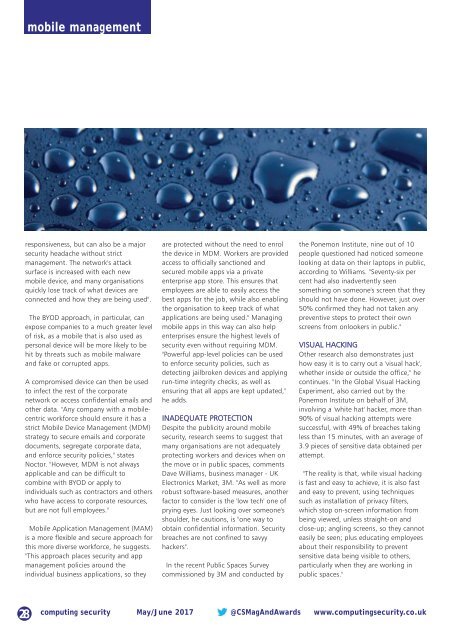CS1705
You also want an ePaper? Increase the reach of your titles
YUMPU automatically turns print PDFs into web optimized ePapers that Google loves.
mobile management<br />
responsiveness, but can also be a major<br />
security headache without strict<br />
management. The network's attack<br />
surface is increased with each new<br />
mobile device, and many organisations<br />
quickly lose track of what devices are<br />
connected and how they are being used".<br />
The BYOD approach, in particular, can<br />
expose companies to a much greater level<br />
of risk, as a mobile that is also used as<br />
personal device will be more likely to be<br />
hit by threats such as mobile malware<br />
and fake or corrupted apps.<br />
A compromised device can then be used<br />
to infect the rest of the corporate<br />
network or access confidential emails and<br />
other data. "Any company with a mobilecentric<br />
workforce should ensure it has a<br />
strict Mobile Device Management (MDM)<br />
strategy to secure emails and corporate<br />
documents, segregate corporate data,<br />
and enforce security policies," states<br />
Noctor. "However, MDM is not always<br />
applicable and can be difficult to<br />
combine with BYOD or apply to<br />
individuals such as contractors and others<br />
who have access to corporate resources,<br />
but are not full employees."<br />
Mobile Application Management (MAM)<br />
is a more flexible and secure approach for<br />
this more diverse workforce, he suggests.<br />
"This approach places security and app<br />
management policies around the<br />
individual business applications, so they<br />
are protected without the need to enrol<br />
the device in MDM. Workers are provided<br />
access to officially sanctioned and<br />
secured mobile apps via a private<br />
enterprise app store. This ensures that<br />
employees are able to easily access the<br />
best apps for the job, while also enabling<br />
the organisation to keep track of what<br />
applications are being used." Managing<br />
mobile apps in this way can also help<br />
enterprises ensure the highest levels of<br />
security even without requiring MDM.<br />
"Powerful app-level policies can be used<br />
to enforce security policies, such as<br />
detecting jailbroken devices and applying<br />
run-time integrity checks, as well as<br />
ensuring that all apps are kept updated,"<br />
he adds.<br />
INADEQUATE PROTECTION<br />
Despite the publicity around mobile<br />
security, research seems to suggest that<br />
many organisations are not adequately<br />
protecting workers and devices when on<br />
the move or in public spaces, comments<br />
Dave Williams, business manager - UK<br />
Electronics Market, 3M. "As well as more<br />
robust software-based measures, another<br />
factor to consider is the 'low tech' one of<br />
prying eyes. Just looking over someone's<br />
shoulder, he cautions, is "one way to<br />
obtain confidential information. Security<br />
breaches are not confined to savyy<br />
hackers".<br />
In the recent Public Spaces Survey<br />
commissioned by 3M and conducted by<br />
the Ponemon Institute, nine out of 10<br />
people questioned had noticed someone<br />
looking at data on their laptops in public,<br />
according to Williams. "Seventy-six per<br />
cent had also inadvertently seen<br />
something on someone's screen that they<br />
should not have done. However, just over<br />
50% confirmed they had not taken any<br />
preventive steps to protect their own<br />
screens from onlookers in public."<br />
VISUAL HACKING<br />
Other research also demonstrates just<br />
how easy it is to carry out a 'visual hack',<br />
whether inside or outside the office," he<br />
continues. "In the Global Visual Hacking<br />
Experiment, also carried out by the<br />
Ponemon Institute on behalf of 3M,<br />
involving a 'white hat' hacker, more than<br />
90% of visual hacking attempts were<br />
successful, with 49% of breaches taking<br />
less than 15 minutes, with an average of<br />
3.9 pieces of sensitive data obtained per<br />
attempt.<br />
"The reality is that, while visual hacking<br />
is fast and easy to achieve, it is also fast<br />
and easy to prevent, using techniques<br />
such as installation of privacy filters,<br />
which stop on-screen information from<br />
being viewed, unless straight-on and<br />
close-up; angling screens, so they cannot<br />
easily be seen; plus educating employees<br />
about their responsibility to prevent<br />
sensitive data being visible to others,<br />
particularly when they are working in<br />
public spaces."<br />
28<br />
computing security May/June 2017 @CSMagAndAwards www.computingsecurity.co.uk

















